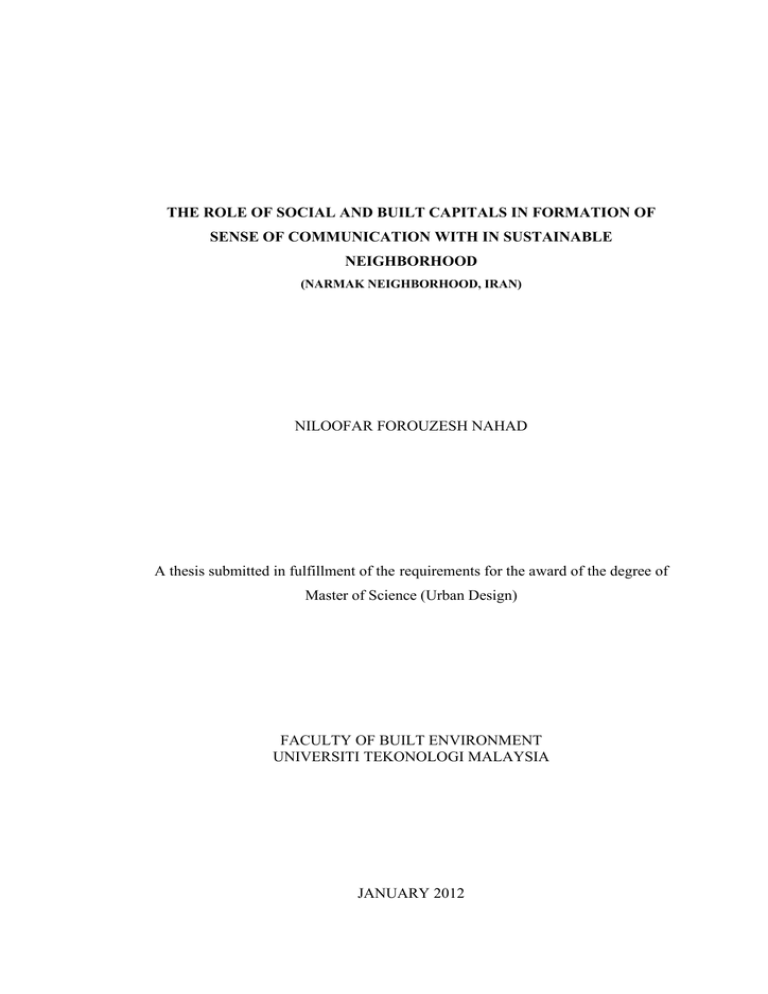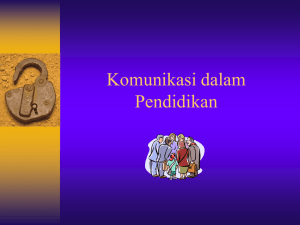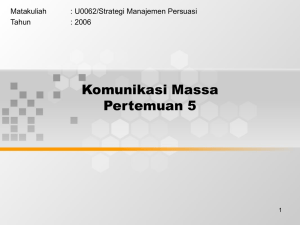THE ROLE OF SOCIAL AND BUILT CAPITALS IN FORMATION OF NEIGHBORHOOD
advertisement

ii THE ROLE OF SOCIAL AND BUILT CAPITALS IN FORMATION OF SENSE OF COMMUNICATION WITH IN SUSTAINABLE NEIGHBORHOOD (NARMAK NEIGHBORHOOD, IRAN) NILOOFAR FOROUZESH NAHAD A thesis submitted in fulfillment of the requirements for the award of the degree of Master of Science (Urban Design) FACULTY OF BUILT ENVIRONMENT UNIVERSITI TEKONOLOGI MALAYSIA JANUARY 2012 iii To my beloved mother and father iv ACKNOWLEDGEMENT The writing of this dissertation has been one of the most significant academic challenges I have ever had to face. Without the support, patience and guidance of the following people, this would not have been completed. It is to them that I owe my deepest gratitude. I especially want to thank my advisor, Dr. Dilshan Remaz Ossen, for his guidance during my research and study at University Technology of Malaysia. His perpetual energy and enthusiasm in research had motivated all his advisers, including me. In addition, he was always accessible and willing to help his students with their research. As a result, research life became smooth and rewarding for me. I was delighted to interact with PROF.Dr Syed Zainol Abidin Idid which was like a second advisor to me, both for my dissertation and for my academic life while at the University Technology Malaysia, and I would like to express my gratitude for that. As is the practice in other country, I refer to him as my “advisor.” My deepest gratitude goes to my family for their unflagging love and support throughout my life; this dissertation is simply impossible without them. I am indebted to my father for his care and loves as typical father in Iranian family. He worked industriously to support the family and spare no effort to provide the best possible environment for me to grow up. He had never complained in spite of all the hardships in his life. I cannot ask for more from my mother as she is simply perfect. I have no suitable word that can fully describe her everlasting love to me. I remember her constant support when I encountered difficulties. Mother, I love you. I feel proud of my sister and her family. They had been a role model for me to follow unconsciously when I was a teenager and have always been one of my best counselors. I especially want to thank my love Reza, whose adore and encouragement allowed me to finish this journey, already has my heart so I will just give him a heartfelt “thanks”. Also, to all my stat friends who have lent a hand to complete this thesis, especially to Mahboubeh Rakhshanifar how for the words of encouragement and for helping me out with my simulations, thank you from the bottom of my heart. Finally, I would like to thank all those who contributed to the dysfunction of some of the communities I observed, which helped me become interested in the topic of “sense of Communication in sustainable neighborhood” in the first place. Last but not least, I would like to thank God for helping me throughout my life and helping me overcome the challenges which I have faced up to now. God has made my life more bountiful. May your name be exalted, honored, and glorified. v ABSTRACT Sense of communication is one of the most important social specifications of sustainable neighborhood that have fallen due to new development and the influence of Western architecture (Zarabadi and Khazae, 2009). This sense has a long history especially in Islamic countries like Iran which is the presenter of several Homogeneous neighborhoods that were shaped based on residence social communications which preserved the Characteristics of cultural, religious, and ethnic values of the area. Despite high level of consideration to social communications in designing Old Iranian cities, most of new planned urban areas are inappropriate in term of social values such as social interactions, interrelationship, communications and etc. and even worth, survival of old and historical neighborhood in Iran is recently under threat by loss of sense of communication among local residents. This study aims to identify and determine the elements which result in creation of communication sense in order to create and maintain a socially sustainable neighborhood. Hence, the main outcome of this study is obtained through comparison between social and built capitals of neighborhoods which are considered as the most effective elements in creation of sense of communication. Doing this research, a quantitative approach has adopted in which two measurements strategies are conducted including: (i) interview with local people, (ii) survey questionnaire. Narmak Neighborhood in Tehran City - Iran is chosen since sense of social communication between neighbors had been noticeably presented in old times in this area; however, unfortunately, this valuable sense is declined and faded out significantly through recent developments. vi ABSTRAK Naluri komunikasi adalah salah satu kepentingan spesifikasi sosial di dalam pengekalan kawasan kejiranan yang telah jatuh bersesuaian dengan pembangunan dan pengaruh seni bina barat (Zarabadi and Khazae, 2009) yang baru. Naluri ini mempunyai sejarah yang panjang terutamanya di dalam nengara-negara islam seperti Iran di mana perwakilan sebahagian kejiranan homogen yang dibentuk adalah berdasarkan kepada komunikasi sosial penduduk yang mana sifat budaya, agama, dan nilai etniknya kawasan tersebut dpelihara. Walaupun kadar pertimbangan adalah tinggi terhadap komunikasi sosial di dalam perekaan Bandar lama Iran, kebanyakkan perancangan kawasankawasan urban adalah tidak sesuai dalam perkara nilai sosial seperti interaksi soasial, hubungkait, komunikasi dan lain-lain, dan walaupun teruk, kadar hidup kawasan kejiranan lama dan bersejarah di Iran kini adalah di bawah ancaman kepupusan naluri komunikasi dikalangan penduduk tempatan. Kajian ini focus kepada mengenalpasti dan menyatakan elemen-elemen yang memberi kesan kepada kewujudan naluri komunikasi bagi mencipta dan mengekalkan pengekalan komunikasi sosial kawasan kejiranan. Seterusnya, hasil utama kajian ini adalah diperolehi melalui perbandingan di antara sosial dan pembinaan ibu kawasan kejiranan yang dipertimbangkan sebagai elemen- elemen efektif dalam penciptaan naluri komunikasi. Melakukan kajian ini, pendekatan kuantitatif diterima pakai dalam dua strategi pengukuran yang dikawal iaitu (i) temubual bersamaa orang tempatan, (ii) kajian soal selidik.



